BioResource Newsletter Vol.5 No.10
|
|
2009/10/30
| Information on Resource-related Events |
 The 5th Symposium of Lotus japonicus and Glycine max The 5th Symposium of Lotus japonicus and Glycine max
"Frontiers of Functional Genetic Analysis and Applications for Practical Crops"
Date and Time: December 2(Wed) 13:00 - December 3(Thu) 12:10, 2009
Place: Conference Room 202, Kazusa Akademia Hall, Kazusa ARC
 The 3rd Rat Resource Research Workshop The 3rd Rat Resource Research Workshop
Date and Time: January 29 (Fri) 13:00 - 17:00
, 2010
Place: International Conference Hall I, Clock Tower Centennial Hall, Kyoto Univ.
Details are available at: http://www.nbrp.jp/
|
|
| Research and Bioresources No. 6 |
|
 Information Infrastructures in Chimpanzee Research Information Infrastructures in Chimpanzee Research
Tetsuro Matsuzawa Director and Professor,
Primate Research Institute, Kyoto University
|

|
|
In order to answer the question "what are human beings? ", research on primates other than humans is necessary. It is not widely known that there are no wild monkeys in Europe and the US. In this respect, Japan is an exception among the developed countries. Many Japanese people have seen monkeys in wild monkey parks and have been raised on the tales of Momotaro-san (Peach Boy) and Sarukani Gassen (The Monkey and the Crab).
Although primates are often equated with monkeys, the group includes not only monkeys but also humans. Some say that primatology is the study of monkeys; however, I consider this to be incorrect. Primatology is in fact the study of humans. Nevertheless, in order to understand the evolutionary history of humans, research on primates other than humans is indispensible.
I have personally been involved in the research on chimpanzees. Common ancestors of chimpanzees and humans existed approximately 6 million years ago. Thereafter, both chimpanzees and humans evolved over millions of years into their present-day forms. Sequencing of the human and chimpanzee genomes was completed in 2003 and 2005, respectively, and the difference in the DNA nucleotide sequences was found to be only approximately 1.23%. In other words, humans share 98.77% identity with chimpanzees.
|
| 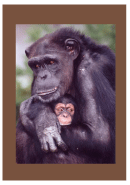
Ai (mother) and Ayumu
|
|

Ayumu working on a computer assignment to test memorization skills.
(Pictures provided by the Primate Research Institute, Kyoto University)
|
|
Since humans are classified in the family Hominidae, genus Homo, and species sapiens sapiens, some people consider that we are special organisms; however, the family Hominidae in fact consists of 4 genera. According to the current taxonomic classification, the Hominidae contains the genera Homo, Pan (chimpanzees), Gorilla, and Pongo (orangutans). Indeed, chimpanzees are also classified into the family Hominidae under Japanese law. Species in Japan that are to be protected are listed in the "Act for the Conservation of Endangered Species of Wild Fauna and Flora," which is a domestic law equivalent to the "Cruelty to Animals Act" or the "Convention on International Trade in Endangered Species of Wild Fauna and Flora (CITES)." "Family Hominidae" and "genus Pan" are specified in the list.
Chimpanzees and humans can be said to be "evolutionary neighbors." Neanderthals became extinct approximately 30,000 years ago and Homo erectus and Australopithecus also became extinct around the same time. Therefore, among living species, chimpanzees are the most closely related to humans.
|
|
Wild chimpanzees inhabit Africa. As recently as 100 years ago, in the early 20th century, no scientific research on primates other than humans had been conducted. At this time, non-human primates were considered to be rare species and were simply exhibited in zoos. However, during the late 20th century, scientific research on primates gradually became more commonplace. Some researchers started to use chimpanzees as subjects in experiments on infectious diseases. For example, many chimpanzees were used for the research on hepatitis during the 1970s and 80s. Such research using chimpanzees enabled us to discover that Hepatitis C was in fact caused by a virus.
Chimpanzees are affected by AIDS, Ebola hemorrhagic fever, and malaria, which is not surprising considering the fact that chimpanzees are almost identical to humans at the DNA level. Meanwhile, the number of chimpanzees in the wild has undergone a rapid decline. The destruction of the chimpanzees' habitats due to deforestation, poaching, and infectious diseases passed on by humans, such as polio and influenza, have been the primary causes of the decline in their numbers. In other words, the number of wild chimpanzees is decreasing as a result of human activities. As a consequence, chimpanzees have been classified as an endangered species by CITES. This treaty was ratified by Japan in 1980. |
|
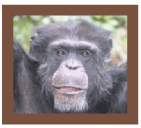
Akira
(father of Ayumu)
|
|
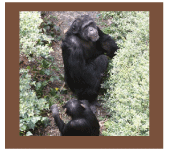
Akira (father) and Ayumu
|
Next year will mark the 30th anniversary of the Japanese ratification of CITES. Public understanding of chimpanzees in Japan has changed dramatically during these 30 years. Chimpanzees are not just large black monkeys; indeed, their ability to memorize numbers by a fleeting glimpse is sometimes considered to be superior to that of humans. As we gain a better understanding of chimpanzees, we will come to recognize that dichotomous classifications such as "humans and other animals" are actually false dichotomies. Humans are also a type of animal. From this perspective, an understanding of chimpanzees will also provide significant insights into the human condition. With advances in this type of understanding, we moved away from using chimpanzees in medical experiments on infectious diseases.
|
|
Currently, there are approximately 345 chimpanzees inhabiting Japan. Nearly one-fifth of these chimpanzees, approximately 60, reside in Uto City in Kumamoto Prefecture. This locality is accordingly referred to as the Chimpanzee Sanctuary Uto (CSU). Previously, experiments on hepatitis infections were conducted using the chimpanzees from this facility. However, such experiments have now been completely abolished, and the facility is currently used as a shelter (sanctuary) for the chimpanzees to enjoy the rest of their lives. The sanctuary is administered by the Wildlife Research Center, Kyoto University.
The CSU serves as a home range for chimpanzees and many of them have been distributed to zoos in several Japanese cities. Recent examples include Kyoto City Zoo and Yokohama Zoorasia. In Kyoto Zoo, chimpanzees who use computers to study numbers can be observed at close range. In Yokohama, chimpanzees live freely and vivaciously in a facility where the natural environment of an African forest has been reconstructed. |
|

Ayumu
|
|
Chimpanzees can no longer be imported because they are classified as an endangered species. They are extremely precious animals. Indeed, the number of chimpanzees in Japan is the second highest in the world after the US. The Japanese population of 345 chimpanzees has been thoroughly monitored, and individual data has been recorded continuously as the "Information Project--Great Ape Information Network (GAIN)," which is a part of the National BioResource Project.
On the GAIN website, which is administered by the National Institute of Genetics, detailed individual information on the chimpanzees inhabiting Japan can be examined. Currently, a project involving the whole genome sequencing of Ayumu, Akira, and Ai, i.e., parents and their child chimpanzee, is in progress. In the not-too-distant future, genome information on all the 345 chimpanzees will be available. Lineages and facial portraits have also been posted on the website. Please visit the website at least once. You will discover that chimpanzees exhibit a range of facial features, just as humans do.�� |
|
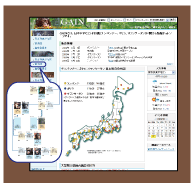
Great Ape Information Network
�iGAI�m�j
http://www.shigen.nig.ac.jp/gain/
|
|
|
|

|
Erudite Lecture Series by Dr. Benno: No. 10 |
|
|
|
Let us eat fermented food !
Many diseases are caused by bacteria but bacteria can also be used to prevent disease. Among the bacteria, lactobacilli exhibit many useful properties, including the prevention of cancers, maintenance of a stable blood pressure, and activation of immune responses. Furthermore, functional yogurts containing such lactobacilli are considered to have beneficial effects on our health.
Probiotics, which has recently been widely recognized, indicates the bacteria that provide beneficial effects on our health. The concept of probiotics involves utilizing the activities of beneficial bacteria that confer positive effects for maintaining our health.
|

|
In the 20th century, Mechnikov in Russia suggested that lactobacilli were responsible for perpetual youth and longevity, and this view stimulated active research on useful lactobacilli. Mechnikov's interest was motivated by knowledge of the consumption of yogurt in Bulgaria, a region renowned for human longevity, and he subsequently turned his attention to the relationship between human health and lactobacilli. During the subsequent 100 years, research on lactobacilli flourished and milk products such as yogurt, cheese, and Lactobacillus beverages were developed. Certain lactobacilli also came to be used in Japanese pickles. Although lactobacilli were first identified approximately 100 years ago, humans had in fact been eating foods fermented by bacteria for over 12,000 years. However, the discovery of various lactobacilli that not only preserve and improve the taste of foods but also have beneficial effects on human health by protecting them against diseases has burgeoned in the 21st century.
What, however, happens if lactobacilli are heated? People in Arabic regions frequently eat boiled foods containing yogurt. In addition, people in India add yogurt to curry. The use of yogurt as an ingredient in cooking will increase our intake of yogurt and the various ways in which we eat yogurt. It is nevertheless clear that the lactobacilli contained in yogurt will be killed if heated at 60°C for 30 min or immediately if heated at temperatures higher than 100°C for a few seconds. However, even the components of dead lactobacilli have certain beneficial effects.
|
If we continue to consume lactobacilli that are appropriate for each of our conditions, and that prevent or enable us to recover from diseases, we will obtain beneficial effects. More importantly, not all the lactobacilli have the properties of lowering blood pressure, suppressing atopic allergy, or eliminating Helicobacter pylori. These functions differ depending on the strains of Lactobacillus. Thus, it is crucial to understand the characteristics of each Lactobacillus strain so that we can utilize lactobacilli to maintain our health, prevent diseases and quicken our recovery from diseases.
|

|
| |
|
|
 Convenient tallying tool (Microsoft Excel Pivot Table) Convenient tallying tool (Microsoft Excel Pivot Table)
Microsoft Excel is equipped with convenient tallying and analysis functions. Advanced calculations can be performed in Excel by using its mathematical functions and programs. However, pivot tables, which will be described here, are frequently used when we would like to easily tally and analyze our data. Although the pivot tables we describe here are from the Windows version of Excel 2007, they are also available in the previous versions of Excel (later than Excel 2000) and in Excel for Macintosh, and thus can be used as long as Excel is installed.
First, we use article data as shown in Fig. 1 to calculate the number of articles according to biological species and published year.
Let's calculate the number of articles according to species and published year! (Fig. 2)
|
|
|
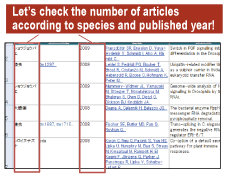
|
Fig. 1: Sample article data
��Data obtained from research resource circulation (RRC), an article registration system (http://rrc.nbrp.jp)
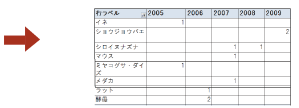
Fig. 2: Target data
|
|
The tallying method in which a data table is arranged based on rows and columns is called cross tabulation, and this can be easily performed by the following two steps using a pivot table.
|
|
�@ Specify the data range for calculation
First, the region of the target data set should be specified for cross tabulation. Click on the "Pivot Table" icon in the "Insert" menu, and then the "Create Pivot Table" window will be displayed as shown in Fig. 3. Next, click on the "select a table or range" radio button and specify the target data region for tallying on the data sheet.

Fig. 3 : Specification of the tallying data range
|
|
|
�A Specify the items for tallying
Next, the "Pivot Table Field List" window will be displayed. Data items are listed in the window, and thus target items should be moved to the sections of column label, row label, and values using the drag-and-drop technique (Fig. 4).
Fig. 4: Specification of the target items for tallying |
|

|
|
Having completed these procedures, the tallied results will be displayed in a tabular form (Fig. 5).
In addition, a graph of the constructed table can easily be prepared using the graph insertion function (Fig. 6).
|
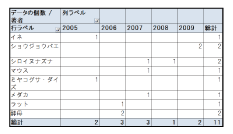
Fig. 5: Constructed table
|
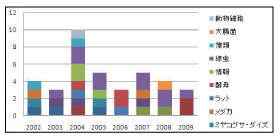
Fig. 6: Resulting graph
|
The function introduced here is the basic function of pivot tables; however, more advanced tallying can be performed by specifying different tallying options. The pivot table can be used for various purposes, including data analysis and tallying for research and daily household accounting. Therefore, I recommend that readers use the pivot table function and realize its usefulness. �@�@�@�@�@�@�@�@�@�@�@�@�@�@
(Takehiro Yamakawa)
|
|
|
Coming up in the next issue !
The special topic on resources in the next month's
issue will be "Resource Center in Korea."
|
|
Editor's Note�F The main topic covered in this newsletter is primates, which is a sequel to the newsletter issued last month. Fortunately, Dr. Matsuzawa, who is the foster parent of Ai, the mother chimpanzee, provided us with an article for this newsletter. We greatly appreciate his contribution. GAIN aims to establish a network of farming facilities and chimpanzee researchers through the sharing of chimpanzee bioresources that are obtained in noninvasive manners, which are also applicable to humans, and the communication of research achievements. I highly recommend that all the readers visit the GAIN website.�iY.Y.)
|
Contact Address�F
1111 Yata, Mishima-shi, Shizuoka 411-8540, Japan
Center for Genetic Resource Information, National Institute of Genetics
Tel: 055-981-6885 (Yamazaki)�@
E-mail brnews@chanko.lab.nig.ac.jp
"translated by ASL translation service and proofread by Sharoh Yip"
|
|

















